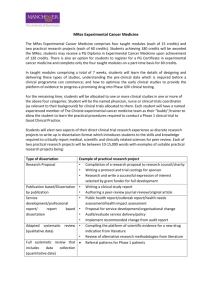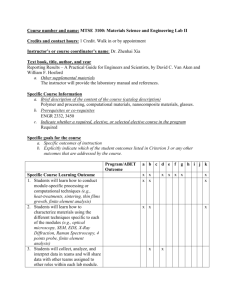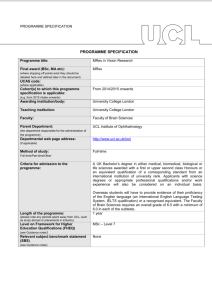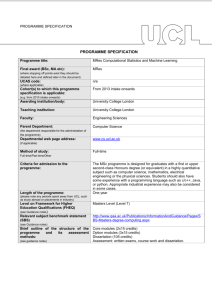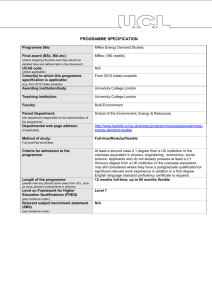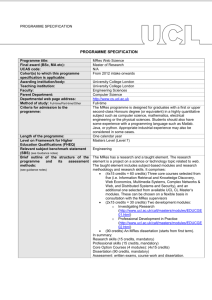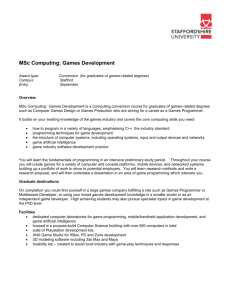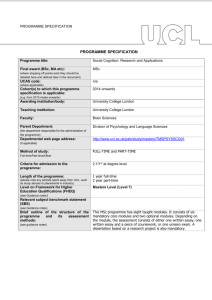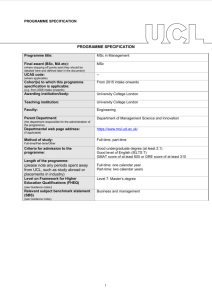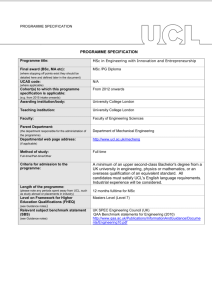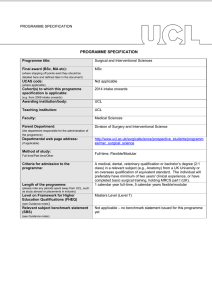MRes Adaptive Architecture and Computation
advertisement
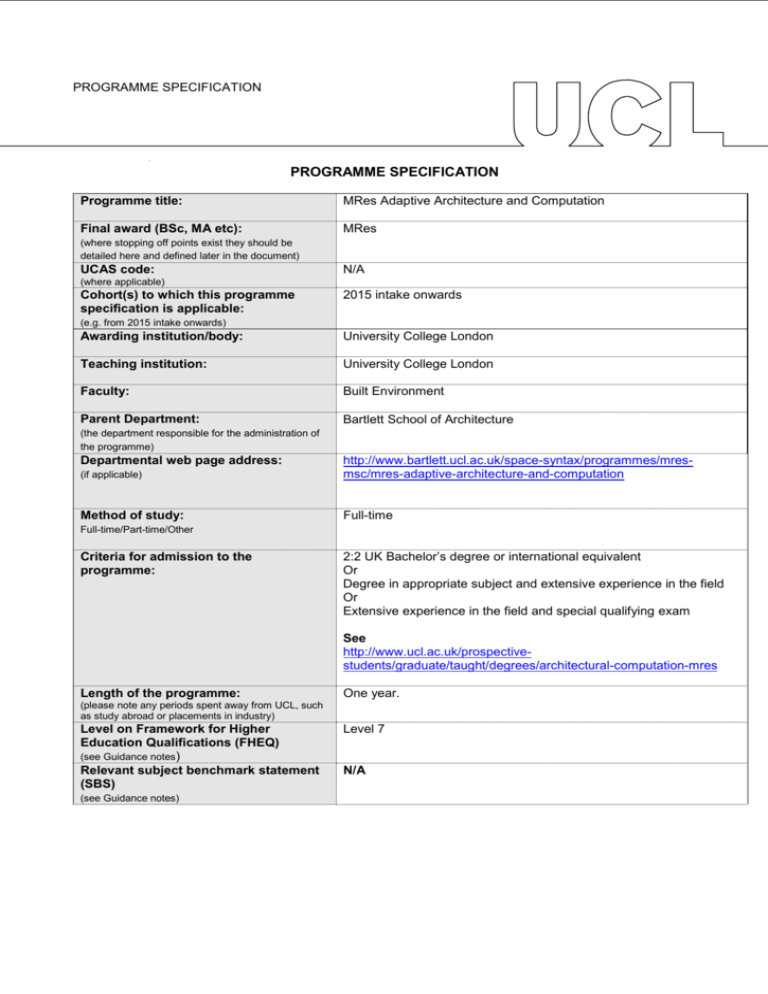
PROGRAMME SPECIFICATION PROGRAMME SPECIFICATION Programme title: MRes Adaptive Architecture and Computation Final award (BSc, MA etc): MRes (where stopping off points exist they should be detailed here and defined later in the document) UCAS code: N/A (where applicable) Cohort(s) to which this programme specification is applicable: 2015 intake onwards (e.g. from 2015 intake onwards) Awarding institution/body: University College London Teaching institution: University College London Faculty: Built Environment Parent Department: Bartlett School of Architecture (the department responsible for the administration of the programme) Departmental web page address: (if applicable) http://www.bartlett.ucl.ac.uk/space-syntax/programmes/mresmsc/mres-adaptive-architecture-and-computation Method of study: Full-time Full-time/Part-time/Other Criteria for admission to the programme: 2:2 UK Bachelor’s degree or international equivalent Or Degree in appropriate subject and extensive experience in the field Or Extensive experience in the field and special qualifying exam See http://www.ucl.ac.uk/prospectivestudents/graduate/taught/degrees/architectural-computation-mres Length of the programme: One year. (please note any periods spent away from UCL, such as study abroad or placements in industry) Level on Framework for Higher Education Qualifications (FHEQ) (see Guidance notes) Relevant subject benchmark statement (SBS) (see Guidance notes) Level 7 N/A Brief outline of the structure of the programme and its assessment methods: (see guidance notes) Board of Examiners: Computational Research Projects (30 credits, mandatory) Group research project (30 credits, mandatory) Research Dissertation (60 credits, mandatory) Transferrable skills: research and professional (30 credits, mandatory) assessed by coursework/seminars Taught Options modules (2 modules, 2x15 credits) assessed by unseen written examination and written coursework Name of Board of Examiners: Bartlett MRes Board of Examiners Professional body accreditation (if applicable): N/A Date of next scheduled accreditation visit: EDUCATIONAL AIMS OF THE PROGRAMME: The programme aims to enable students to undertake advanced courses and independent research in technologies, applications, and professional skills pertaining to computational techniques as applied to architecture, through a thorough understanding of those techniques and their social and spatial consequences. Students will be able to draw upon, in consultation with their assigned supervisor, a range of specialized research projects and taught modules (including programming and analytical modules).These will provide foundation training in the scientific basis of relevant computational systems, taking into account the student’s preexisting experience and future interests. The modules allow the students to further explore the details of such systems for a range of main fields of applications as well as providing a set of transferable skills. Specifically, that students will be able to: 1. Use computational techniques in architecture 2. Understand and predict the consequences of their design actions through computational processes, and integrate their predictions into the design process 3. Carry out self-sufficient research into new methods and processes PROGRAMME OUTCOMES: The programme provides opportunities for students to develop and demonstrate knowledge and understanding, qualities, skills and other attributes in the following areas: A: Knowledge and understanding Knowledge and understanding of: (a) The role of computation in architectural process and product (b) The theory of embedded, embodied, and adaptive architecture, including background in cybernetics (c) Generative techniques to create form and function, including emergent systems (d) Interrelationships between society, space, and computation including behavioural response, and the role of interactive and responsive systems Teaching/learning methods and strategies: (a) and (b) Through lecture material presented mainly in 2-3 hour lecture or seminar slots, backed up by seminars. (c) and (d) through in depth lectures and guest lectures also following the 2-3 hour slot system (e) through practical exposure to generative, responsive and emergent techniques as well as through taught lecture material (e) In depth understanding of algorithmic techniques for computation in architecture Assessment: Unseen examination and written coursework, as well as through practical exercises and presentations B: Skills and other attributes Intellectual (thinking) skills: (a) Take an analytic / synthetic approach to the investigation of research problems (b) Be able to critically review material such as texts, research papers as well as their own work (c) Take a scientific approach to research projects by setting out research questions and hypothesis, and answering these with a practical or theoretical experiment (d) Critical assessment of research conducted via computational means. (e) Critical assessment of the application of technology in practice. Teaching/learning methods and strategies: (a) Through a series of practical projects throughout the year, culminating in the final dissertation (b) Through seminar sessions in taught modules, exercises in transferrable research skill module (c) Through stepwise introduction to the process in all modules, setting up the final dissertation (d) and (e) Through dissertation project supervision and group research Assessment: Practical projects with presentation components, a collaborative group research project, written coursework and final dissertation C: Skills and other attributes Practical skills (able to): (a) Use programming skills to address architectural problems (b) Use specific software to enhance architectural design processes (c) Present seminar material (d) Listen and discuss ideas introduced during seminars (e) Synthesize theory and practical application of technology in context of research projects (f) Formulate research questions and appropriate means by which to investigate them. (g) Plan and execute research projects. Teaching/learning methods and strategies: (a) The main approach is practical classes, 3-4 hours long, where a variety of teaching styles are employed: from self-study on computers, to follow along sessions and brief theoretical lecture components (b) Through workshops and practical classes (c) and (d) Through both introductory seminars and within subject specific seminars in later modules (e) through projects in taught modules, group project and individual research supervision (f) and (g) Through group and individual research projects. Assessment: Practical coursework, group projects and final dissertation D: Skills and other attributes Transferable skills (able to): Ability to work in a team; lead research; use technology appropriately; use data and literature resources appropriately (a) Write concise, evidence-based, theoretically grounded reports. (b) Effectively communicate the results of practical investigations (c) Create new analytic techniques and design processes based on sound understanding of computational theory (d) Synthesise research results in order to address a specific problem (e) Form considered judgements about the computational, spatial and social qualities of a design through an understanding of their interrelationships (f) Manage projects, time and work to deadlines Lead research Use data and literature resources appropriately Work in a team Teaching/learning methods and strategies: (a) Through writing essays and reports, receiving detailed feedback and the opportunity to submit revised work (b) Through presentations and project work throughout the year (c,d,e) Through dissertation work, project reviews and seminar interaction (f,g,h,i) Through module coursework through the year, collaborative group project and dedicated transferrable skills modules Assessment: (a,d,e) Through a variety of written coursework and final dissertation (b,c,d) Through presentation of researched material and practical investigations (f,g,h,i) Through a series of projects throughout the year and coursework presentation/participation in dedicated skills modules. The following reference points were used in designing the programme: the Framework for Higher Education Qualifications: (http://www.qaa.ac.uk/en/Publications/Documents/qualifications-frameworks.pdf); the relevant Subject Benchmark Statements: (http://www.qaa.ac.uk/assuring-standards-and-quality/the-quality-code/subject-benchmark-statements); the programme specifications for UCL degree programmes in relevant subjects (where applicable); UCL teaching and learning policies; staff research. Please note: This specification provides a concise summary of the main features of the programme and the learning outcomes that a typical student might reasonably be expected to achieve and demonstrate if he/she takes full advantage of the learning opportunities that are provided. More detailed information on the learning outcomes, content and teaching, learning and assessment methods of each course unit/module can be found in the departmental course handbook. The accuracy of the information contained in this document is reviewed annually by UCL and may be checked by the Quality Assurance Agency. Programme Organiser(s) Dr Sean Hanna Name(s): Date of Production: January 2010 Date of Review: October 2015 Date approved by Chair of Departmental Teaching Committee: Date approved by Faculty Teaching Committee October 2015 October 2015
